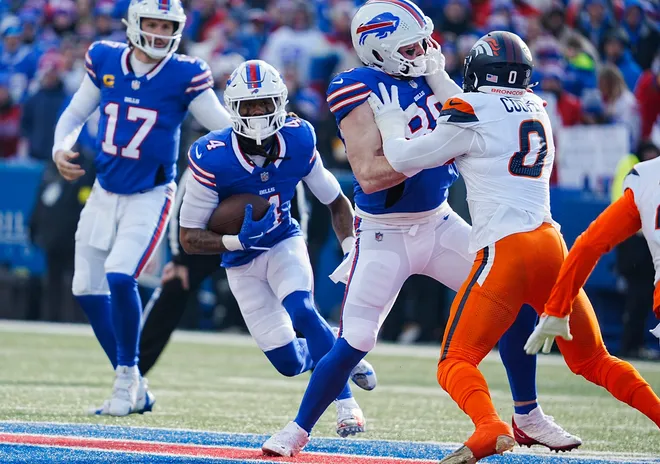When analyzing the Denver Broncos vs Buffalo Bills match player stats, it becomes evident how one team dominated while the other struggled to keep pace. In the Wild‑Card Round of the 2024‑25 NFL playoffs, the Buffalo Bills defeated the Denver Broncos 31‑7. This article provides a detailed breakdown of individual performances, team statistics, and what these numbers reveal about each team’s strengths and weaknesses. Understanding these stats offers fans, analysts, and coaches valuable insights into both strategy and execution at the highest level of football.
Game Context: Setting the Stage
The Broncos and Bills faced off on January 12, 2025, at Highmark Stadium in Orchard Park, New York. The Bills, playing at home, leveraged their offensive and defensive strengths to dominate time of possession, yardage, and big plays. The Broncos, on the other hand, struggled to establish rhythm, particularly as rookie quarterback Bo Nix faced intense defensive pressure throughout the game. The matchup highlighted the contrast between a seasoned playoff contender and a young team still finding its footing under pressure.
Key Player Stats from the Bills
Quarterback: Josh Allen
Josh Allen delivered a commanding performance, completing 20 of 26 passes for 272 yards and 2 touchdowns, while also rushing for 46 yards. His dual-threat capability kept the Broncos’ defense off balance, enabling the Bills to sustain drives and capitalize on scoring opportunities. Allen’s ability to manage the game efficiently was a key factor in Buffalo’s playoff success.
Running Game: James Cook & Ty Johnson
Running back James Cook rushed for 120 yards and a touchdown, marking a playoff milestone for the Bills. Ty Johnson added 44 rushing yards and a decisive 24‑yard touchdown run. Together, they established a balanced rushing attack that wore down Denver’s defensive line and opened up opportunities in the passing game. Their contribution underscores the importance of a strong ground game in high-stakes matches.
Receiving Corps: Curtis Samuel & Others
Curtis Samuel’s 55‑yard touchdown reception early in the fourth quarter effectively sealed the game. Tight end Dalton Kincaid and receiver Khalil Shakir also contributed crucial yardage, helping maintain offensive balance. This receiving depth allowed the Bills to stretch the field and exploit mismatches, keeping the Broncos’ secondary on their heels throughout the game.
Defense and Team Advantage
Buffalo’s defense forced the Broncos into difficult situations, limiting them to just 224 total yards compared to Buffalo’s 471. The Bills’ time of possession advantage of over 40 minutes allowed them to control the tempo and keep Denver’s offense off the field. The team’s defensive discipline, combined with opportunistic plays, contributed significantly to the lopsided score.
Key Player Stats from the Broncos

Quarterback: Bo Nix
Bo Nix completed 13 of 22 passes for 144 yards and 1 touchdown, adding 43 rushing yards. Despite showing promise, Nix faced pressure on over half of his dropbacks, highlighting the challenges for a rookie quarterback against a playoff-caliber defense. His stats reflect both potential and the need for experience in managing high-pressure situations.
Receiving: Courtland Sutton & Troy Franklin
Courtland Sutton led Denver with 5 receptions for 75 yards. Rookie Troy Franklin scored a 43‑yard touchdown early in the game, giving the Broncos an initial boost. However, the Bills’ defense adjusted quickly, limiting further big plays. The receiving corps showed flashes of talent but struggled to sustain drives under consistent pressure.
Running Game and Offensive Struggles
Denver was unable to establish a consistent rushing attack, gaining only 79 yards on the ground. Their limited success in the run game made third-down conversions difficult, keeping the offense from maintaining momentum. These struggles allowed the Bills to dictate the pace and continue aggressive defensive strategies without significant fatigue.
Defensive Effort and Limitations
Although Denver’s defense made some stops, they could not contain Buffalo’s balanced offensive attack. The inability to generate turnovers and limit big plays allowed Buffalo to maintain control throughout the game. Extended time on the field, due to Denver’s short offensive drives, further strained the defense and contributed to the team’s struggles.
Comparative Insights: What the Stats Reveal
The Denver Broncos vs Buffalo Bills match player stats provide several key takeaways. First, offensive balance proved critical, as Buffalo’s combination of passing and rushing kept Denver off balance. Second, pressure and inexperience on the quarterback’s part played a major role in Denver’s difficulties. Third, time of possession underscored the importance of controlling the game tempo. Big plays shifted momentum in Buffalo’s favor, and defensive execution enabled consistent dominance throughout. These statistics highlight the gap between playoff experience and a team still developing under pressure.
Real‑Life Applications for Coaches and Analysts
Coaches and analysts can draw lessons from this game regarding preparation and strategy. Facing a dual-threat offense requires disciplined edge containment, strong tackling, and minimizing third-down failures. For teams with rookie quarterbacks, protecting them from relentless pressure and establishing a consistent rushing attack are vital for postseason success. The Denver Broncos vs Buffalo Bills match player stats serve as a case study in execution, strategy, and the cumulative effect of team balance under playoff conditions.

Conclusion
In conclusion, the Denver Broncos vs Buffalo Bills match player stats clearly illustrate why the Bills dominated and why the Broncos struggled. Buffalo’s offensive balance, strategic time of possession, and opportunistic defense produced a decisive victory. Denver showed flashes of potential, particularly from Bo Nix and the receiving corps, but the inability to establish a run game and handle defensive pressure was decisive. The insights from this game are invaluable for fans, analysts, and coaches, providing a detailed understanding of how playoff football is won and lost.
FAQs
Q1: What was the final score of the Denver Broncos vs Buffalo Bills game?
A1: The Buffalo Bills defeated the Denver Broncos 31‑7.
Q2: Who were the top performers for each team?
A2: For the Bills: Josh Allen, James Cook, Curtis Samuel. For the Broncos: Bo Nix, Courtland Sutton, Troy Franklin.
Q3: How did time of possession affect the outcome?
A3: The Bills’ 41:43 of possession allowed them to control the tempo, rest their defense, and keep the Broncos’ offense off the field.
Q4: Did any player achieve a notable playoff milestone?
A4: James Cook became the first Bills player since Thurman Thomas in 1995 to rush for over 100 yards and a touchdown in a playoff game.
Q5: What were the Broncos’ main weaknesses?
A5: Denver struggled to establish the run, convert third downs, and protect rookie quarterback Bo Nix from high pressure.
Read Also : Baltimore Ravens vs Bengals Match Player Stats: In-Depth Analysis

